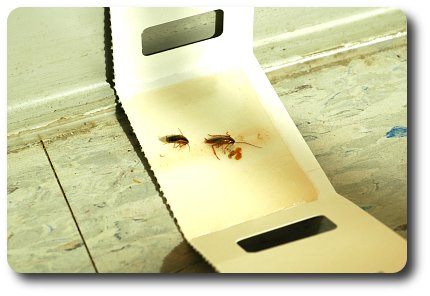Many of us have shared the joys of living in a communal setting such as an apartment complex or dormitory, entering the kitchen for a late night snack and watching cockroaches scuttle for refuge beneath the refrigerator when we turn on the light. What a delight! Cockroaches are among the most successful and enduring life forms on the planet. Their lineage can be traced back more than 300 million years. Cockroaches flourished in primeval forests when warm temperatures and abundant decaying organic matter provided conditions favorable for survival. Most people don’t realize that the vast majority of cockroaches are denizens of the great outdoors. What are these roaches doing in our homes? When our ancestors began to build shelters and occupy dwellings such as caves, it is likely that cockroaches moved right in to take advantage of the hospitable conditions and a ready supply of food, water, and hiding places.
This little German cockroach is carrying a boat load of eggs in the ootheca extending from the tip of her abdomen.
Cave dwellers were notoriously poor housekeepers and it is likely that many bones, hides, grain, and decaying vegetables were scattered about. Several species of cockroaches evolved along with us and are regularly found in human habitations throughout the world. Cockroaches eat a wide variety of food and nonfood items. High on the list of favored cuisine for our oriental and German cockroaches are starchy foods such as cereal, pet food, and sweet, sticky treats such as jam and fruit. They will also consume beer, meat, leather, the starch in book-bindings and paper goods. There are rather macabre records of German cockroaches eating the eyebrows and eyelashes of humans in heavily infested apartments. In addition to the nuisance factor several types of pathogenic organisms such as those causing dysentery have been associated with cockroaches. Although it has been difficult to link outbreaks of human disease to cockroach infestations, there is a belief that cockroaches can spread disease agents such as Salmonella from contaminated places like sewers to foods, food preparation surfaces, or utensils.
Oriental cockroaches deposit their egg cases on the ground near sources of food.
Proteins associated with cockroaches are known to cause allergic reactions in many people especially asthmatics. The German and oriental cockroaches probably arrived in North America with early trade ships from Europe during the colonial period. They are well established in cities large and small throughout the world making them among the most cosmopolitan of insects. The German cockroach is one of the most prolific of all species associated with man. For weeks the female carries her unborn babes in an egg case called an ootheca that can be seen protruding from the tip of her abdomen. Each ootheca contains 30 – 40 eggs. The oriental roach also protects her egg in an ootheca but the egg case usually is carried for only a few days before she deposits it near a source of food. German roaches are often found in kitchens and bathrooms where they have easy access to food, water, and hiding places.
This sticky trap is the end of the line for two hapless German roaches.
Oriental roaches do well in dark, damp places and are often found in basements or crawl spaces were water pipes are leaking. They can move about apartment buildings through garbage shoots. They will often use sewer lines or electrical conduits to move between buildings. In fact, the oriental roaches in this bug of the week were collected in a water-filled junction box carrying electrical conduits between housing units. Cockroaches arrive in our homes with food or other packages brought from infested grocery stores, restaurants, workplaces, or dwellings. Some cockroaches, like the oriental roach, may move in from outdoors.
Reducing populations
One way to reduce the chances of bringing roaches into your home is to carefully inspect all packages before you bring them in. If your home is a multiple family dwelling such as an apartment, then apply caulk to eliminate gaps around pipes and electrical conduits and install or replace door sweeps to help reduce the movement of roaches from your neighbor’s home to yours. Remember that roaches need food, water, and harborage to survive. Keeping pipes and faucets in good repair to stop leaks and emptying pet water bowls at night will reduce the availability of water for roaches. Good sanitation including cleaning up spills on floors and in cupboards, emptying pet food dishes, and cleaning food laden sink strainers will reduce the availability of food. Storing dry goods in sealed containers will help keep roaches out. Reducing clutter such as paper bags and boxes under sinks and in cabinets reduces hiding places for roaches and makes them susceptible to insecticidal treatments. Non-insecticidal sticky traps are available to catch roaches as they move about your home. These may not control roaches but they can help identify locations where roaches are abundant. Insecticidal cockroach baits and baited traps can be very effective killing cockroaches. Several brands of cockroach sprays and dusts are also available. All insecticides should be used according to information contained on the product label. If you don’t want to tackle the task of cockroach elimination alone, there are many fine pest control firms in the area that have the tools and techniques to help get the job done. These ancient insects are a marvel to behold but not in your kitchen when you turn on the light.
References:
Much of the information for this week’s bug of the week was gleaned from the Handbook of Pest Control by Mallis 1997. I give special thanks to Chris Garcia and Charles Kramer for wrangling roaches for this story.
For more information on cockroaches and their management, please visit the following web sites.
http://www.agnr.umd.edu/users/hgic/pubs/online/cockroaches_pfv.pdf
http://ohioline.osu.edu/hyg-fact/2000/2099.html
http://ohioline.osu.edu/hyg-fact/2000/2097.html



